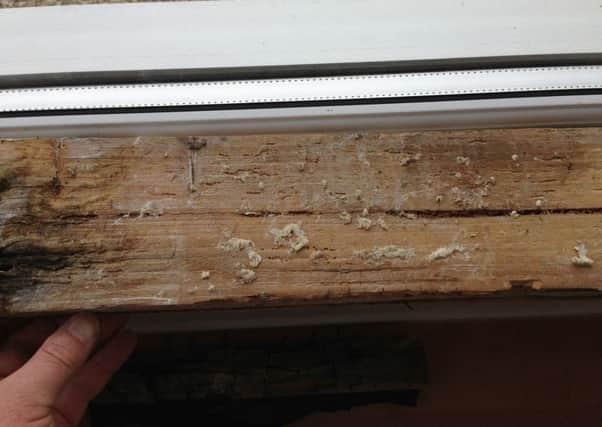Wet weather sparks rot warning for householders


Warmer temperatures and high levels of rainfall can provide a perfect breeding ground for both wet and dry rot to thrive, a national trade body is warning.
Property Care Association chief executive Stephen Hodgson said: “Wet and dry rot is caused by excessive moisture coming into a property.
Advertisement
Hide AdAdvertisement
Hide Ad“Water can enter a building due to damaged roof tiles, blocked gutters and leaking water pipes, as well as poor ventilation of the timber within.
“The recent wet weather has tested the most weathertight of properties and meant that homes can be drawing in much more moisture than usual.”
“If water does enter a building, simple property maintenance, and the affected timber drying out, is usually all that is needed to prevent rot setting in.”
“Wet and dry rot can affect buildings of all ages, and the tell-tale signs include a darkening of the wood and a cracked appearance.
Advertisement
Hide AdAdvertisement
Hide Ad“If fungal decay is discovered, remedial action should be taken without delay.
“Wet rot is caused by wood being in contact with damp masonry. Exposure to high levels of water over long periods leads to a natural breakdown process, seen in all natural organic materials.
“It is usually seen on untreated wood that is exposed to the elements, such as window frames, and does not spread beyond the area of dampness.
“Less common but generally more problematic is dry rot. Although the term dry rot conjures up an association with dry, arid environments, the name is misleading as a moisture content in excess of 20 per cent is needed before such fungi will develop.
Advertisement
Hide AdAdvertisement
Hide Ad“The reason it can be more problematic and damaging is due to the fact that filaments of dry rot fungus can spread a considerable distance over and through masonry to affect timber away from its original source.”
Outbreaks of dry rot and wet rot start in similar ways. The mature fruiting bodies of wood-destroying fungi that develop during an attack produce millions of microscopic spores, and these are dispersed by air currents.
If they fall on untreated damp wood, they will germinate by pushing out a hollow tube called a hypha, which grows and branches to form a mass of hyphal threads called mycelium.
Mycelium develops inside the timber and breaks down the wood for food. The timber may darken in colour and develop a characteristic cracked appearance. Some wet rots may result in bleaching of the wood, and these are more common in doors and window frames.
Advertisement
Hide AdAdvertisement
Hide AdEventually, the wood loses its strength and, in some situations, it may become dangerously unsafe.
Mr Hodgson added: “It is very important that the two types of decay be distinguished since they require different treatment.
“Although wet and dry rot can cause worry for the owners of an affected property, treatments have evolved over the years to make these problems much easier to remedy.
“Modern techniques place emphasis on the preservation of existing timber and minimising the level of structural works.
Advertisement
Hide AdAdvertisement
Hide Ad“Timber treatment methods have evolved considerably, and modern techniques now achieve pinpoint accuracy, ensuring minimal impact on a property and its occupants.
“If timber treatment is to be less intrusive, it is essential that any problems with rot are diagnosed accurately and that any remedial treatment required is carried out through a member of the PCA.
“Careful assessment is needed to address the issue promptly and accurately.”
More information on wet and dry rot can be found on the PCA website at www.property-care.org/Homeowners.Timber_Treatment.asp